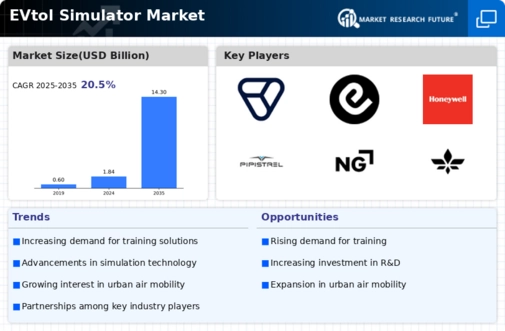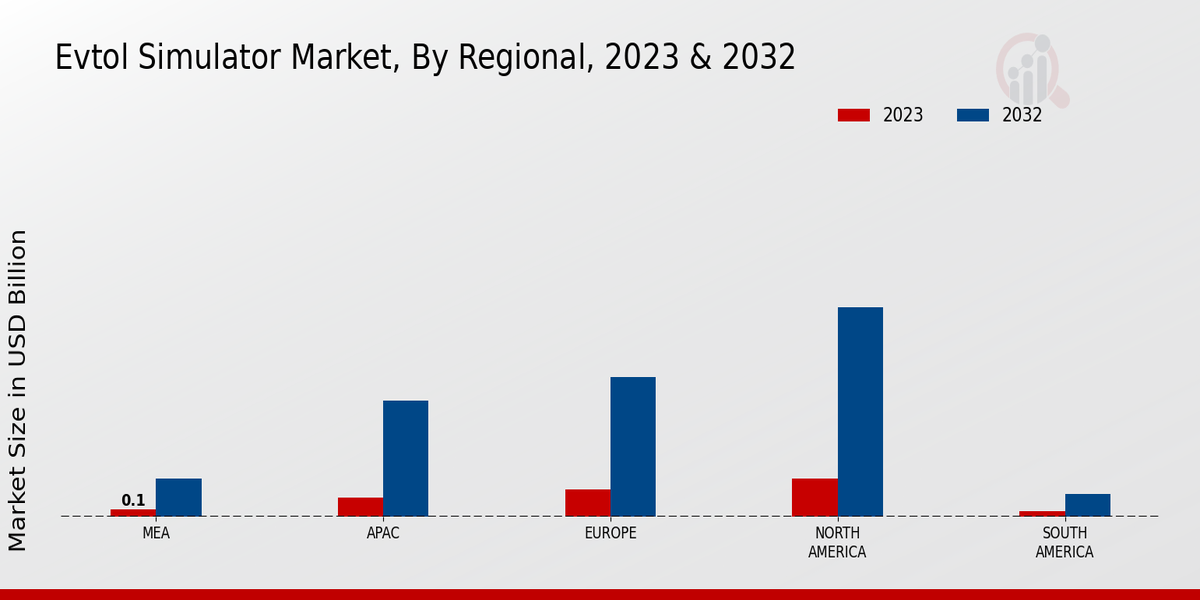Market Growth Projections
The Global EVtol Simulator Market Industry is projected to witness substantial growth over the coming years. The market is expected to expand from 1.84 USD Billion in 2024 to an impressive 14.3 USD Billion by 2035. This growth trajectory indicates a robust compound annual growth rate of 20.52% from 2025 to 2035, driven by various factors including technological advancements, regulatory support, and increasing investments in aviation training. Such projections underscore the potential of the eVTOL simulator market as it aligns with the broader trends in urban air mobility and aviation safety.
Growing Urban Air Mobility Initiatives
The Global EVtol Simulator Market Industry is significantly influenced by the rising initiatives aimed at promoting urban air mobility. Governments and private entities are investing in infrastructure and regulatory frameworks to facilitate the integration of eVTOL aircraft into urban environments. For example, cities like Los Angeles and Singapore are actively exploring air taxi services, which necessitate comprehensive simulation training for pilots and operators. This trend underscores the importance of simulation tools in preparing for real-world operations, thereby driving market growth as stakeholders seek to ensure safety and efficiency in urban air transportation.
Regulatory Support and Standardization
The Global EVtol Simulator Market Industry is positively impacted by regulatory support and the push for standardization in the eVTOL sector. Regulatory bodies are establishing guidelines that promote safety and operational efficiency, which in turn necessitates the use of simulators for compliance training. For instance, the Federal Aviation Administration is working on frameworks that require simulation training for eVTOL pilots. This regulatory landscape not only enhances the credibility of simulation tools but also encourages investment in the development of advanced simulators, thereby fostering market growth as stakeholders align with evolving standards.
Technological Advancements in Simulation
The Global EVtol Simulator Market Industry is experiencing rapid technological advancements that enhance the realism and effectiveness of simulations. Innovations in software algorithms and hardware capabilities allow for more accurate modeling of flight dynamics and environmental conditions. For instance, the integration of artificial intelligence in simulators enables adaptive learning experiences for users, improving training outcomes. As a result, the demand for sophisticated simulation tools is likely to increase, contributing to the market's projected growth from 1.84 USD Billion in 2024 to an estimated 14.3 USD Billion by 2035, reflecting a compound annual growth rate of 20.52% from 2025 to 2035.
Increased Investment in Aviation Training
The Global EVtol Simulator Market Industry is benefiting from heightened investments in aviation training programs. As the demand for skilled personnel in the eVTOL sector escalates, educational institutions and training centers are expanding their offerings to include advanced simulation technologies. This shift is evident in partnerships between universities and eVTOL manufacturers, aimed at developing specialized training curricula. Such initiatives not only enhance the skill set of future pilots but also stimulate the demand for high-quality simulators, further propelling market growth. The emphasis on training is crucial as the industry prepares for the anticipated surge in eVTOL operations.
Rising Demand for Safety and Risk Management
The Global EVtol Simulator Market Industry is increasingly driven by the growing emphasis on safety and risk management in aviation. As eVTOL operations expand, the need for rigorous training and preparedness becomes paramount. Simulators provide a controlled environment for pilots to experience emergency scenarios and develop critical decision-making skills. This focus on safety is reflected in the increasing allocation of resources towards simulation technologies, as organizations prioritize risk mitigation strategies. Consequently, the demand for advanced simulators is expected to rise, contributing to the overall growth of the market as stakeholders seek to enhance operational safety.














